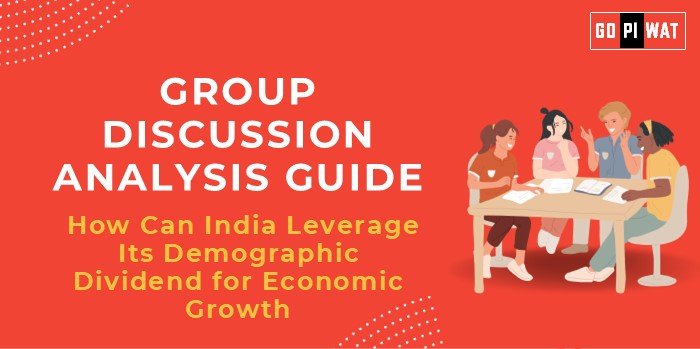📋 Group Discussion Analysis Guide
📝 Topic: How Can India Leverage Its Demographic Dividend for Economic Growth?
🌐 Introduction to the Topic
🌍 Opening Context: India, with a median age of 28 years, stands as one of the youngest nations globally. This demographic dividend presents a strategic opportunity for economic transformation, provided it is effectively harnessed.
📜 Topic Background: The term “demographic dividend” refers to the accelerated economic growth that can result from an increase in the working-age population. For India, this phase is projected to last until 2055, making it imperative to act now to capitalize on this window.
📊 Quick Facts and Key Statistics
- 👨👩👧👦 Median Age: 28 years (2023) – Among the youngest globally.
- 💼 Working-Age Population: 67% of the total population – Significant workforce potential.
- 📉 Unemployment Rate: 7.8% (2024) – Highlights challenges in employment generation.
- 📚 Youth Literacy Rate: 97% – Indicates a strong foundation for skill development.
- 🔧 Skilled Workforce: Only 4.7% formally trained (2024) – Scope for improvement.
🎯 Stakeholders and Their Roles
- 🏛️ Government: Formulates policies on education, employment, and health to harness the workforce potential.
- 💼 Private Sector: Generates employment and upskills workers through initiatives like apprenticeships.
- 🎓 Educational Institutions: Focus on providing quality education aligned with industry needs.
- 🌍 International Organizations: Offers technical and financial support for capacity building and workforce training.
- 👥 Civil Society: Promotes awareness about opportunities and ensures inclusivity.
🏆 Achievements and Challenges
🔑 Achievements
- 🎓 Education: Gross enrollment ratio in higher education reached 27.3% (2023).
- 🔧 Skill Development: Initiatives like Skill India have trained 6 million people annually.
- 📱 Digital Adoption: Online education platforms have seen a surge in adoption.
⚠️ Challenges
- 📉 Unemployment: Rising levels despite a large working-age population.
- 🔧 Skill Gaps: Mismatch between academic learning and industry needs.
- 🏥 Health Infrastructure: Inadequate healthcare facilities affect workforce productivity.
🌍 Global Comparisons
- 🇨🇳 China: Leveraged its demographic dividend during the 1990s for economic takeoff through mass industrialization and urbanization.
- 🇰🇷 South Korea: Focused on education and innovation to maximize its youth potential.
📖 Case Studies
- 📍 Kerala: High literacy and healthcare standards have improved workforce quality.
- 🏭 Rajasthan’s Job Creation Model: Promoted startups and MSMEs to absorb youth workforce.
🗣️ Structured Arguments for Discussion
- ✅ Supporting Stance: “India’s demographic dividend is a growth driver; with proper policies, it can replicate China’s success in manufacturing.”
- ❌ Opposing Stance: “Without addressing unemployment and skill gaps, the demographic dividend could become a demographic disaster.”
- ⚖️ Balanced Perspective: “India must simultaneously address education, employment, and health to leverage its demographic dividend effectively.”
💡 Effective Discussion Approaches
🌟 Opening Approaches
- 📊 “With 67% of its population in the working age, India’s potential is unparalleled globally.”
- 🌏 “India faces a crossroads; it can choose South Korea’s path of innovation or risk stagnation like Brazil.”
🎯 Counter-Argument Handling
- 💬 Rebut skill gap concerns by citing government programs like Skill India.
- 📈 Address employment issues by showcasing rising startup ecosystems.
📊 Strategic Analysis of Strengths and Weaknesses
- 💪 Strengths: Large youth population, growing digital infrastructure, government initiatives like Make in India.
- 📉 Weaknesses: Skill gaps, rural-urban disparity in opportunities, inadequate health services.
- 🌟 Opportunities: Industrialization, global outsourcing hub, digital economy growth.
- ⚠️ Threats: Brain drain, increasing automation, socio-economic disparities.
📚 Connecting with B-School Applications
- 🧠 Real-World Applications: Analyze how industries like manufacturing, IT, and healthcare can employ the demographic dividend.
- 📋 Sample Interview Questions:
- 🤔 “What policies can India adopt to prevent its demographic dividend from turning into a burden?”
- 💼 “How can public-private partnerships enhance skill development?”
- 💡 Insights for B-School Students:
- 📈 Explore workforce optimization projects.
- 🔧 Research entrepreneurship opportunities and rural employment schemes.


